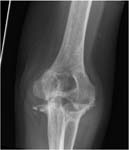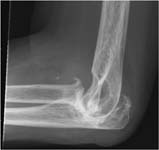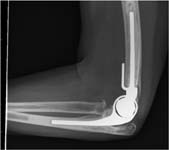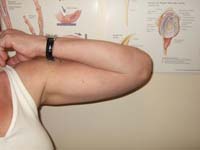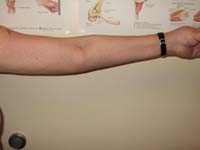The elbow joint is complex. The elbow joint consists of three different bones (the humerus, the radius, and the ulna) with different articulations (the ulnohumeral joint, the radiocapitellar joint, and the proximal radioulnar joint).
The combination of elbow flexion and extension, as well as forearm rotation, allows for placement of the hand for activities of daily living.
In addition to severe elbow pain, the stiffness from elbow arthritis can become disabling, making it difficult to perform simple activities.
Symptoms of Elbow Arthritis
Elbow pain, stiffness, and swelling
Initial symptoms of elbow arthritis include pain and stiffness around the elbow, as well as swelling. Patients find that it becomes increasingly difficult to bend or straighten the elbow. Patients often experience pain with forearm rotation as well.
Additional symptoms of elbow arthritis include locking of the elbow or catching sensation from loose bodies in the elbow. Initially, most patients have pain with lifting or with extremes of motion.
In advanced stages, elbow pain can be severe at night or at rest during the daytime. In some cases, patients can also have feelings of instability and weakness in the elbow.
Causes and Risk Factors of Elbow Arthritis
Rheumatoid arthritis
Rheumatoid arthritis is an autoimmune disease where your body’s immune system attacks the synovium, or the tissue lining the joints. There is progressive erosion and destruction of the cartilage and bone, leading to severe pain, stiffness, and deformity.
Osteoarthritis
Normal cartilage provides a smooth gliding surface for joint motion as well as cushioning. As the cartilage becomes thin over time, the bones begin to grind against each other on rough surfaces (bone on bone). Bone spurs or osteophytes form inside the joint. In addition, loose bodies in the joint may cause catching symptoms as well as accelerate degeneration from mechanical wear.
Post-traumatic arthritis
One of the most common causes of arthritis in the elbow is post-traumatic arthritis. Patients with a prior fracture or dislocation of the elbow can have cartilage injury, leading to progressive deterioration of the joint. These include fractures of the distal humerus, radial head fractures, and olecranon fractures. In complex injuries, there are often large cartilage defects and deformities of the elbow, leading to abnormal mechanics and rapid wear of the joint.
Treatment of Elbow Arthritis
Initial Treatment
A number of conservative measures are helpful to decrease pain and maintain function of the elbow.
Heat and Ice
Heat can be helpful in loosening joints and relaxing stiff muscles. As the elbow joint is often stiff in the morning, you could try morning showers or heat pads first thing in the morning. Ice is generally effective for flare-ups or swelling at the end of the day, especially after overdoing activities.
Over the counter medications
Tylenol and nonsteroidal anti-inflammatory drugs (NSAIDs) may be taken for pain relief. NSAIDs have the added benefit of decreasing inflammation and swelling. In an acute flare-up, it can be helpful to take scheduled doses of NSAIDs for 5-7 days. NSAIDs include ibuprofen (Motrin, Advil), naproxen (Aleve), and several others that are prescription strength. NSAIDs should always be taken with food. Long-term usage in high doses can lead to serious side effects including gastric ulcers, gastrointestinal bleeding, and kidney damage.
Patients with rheumatoid arthritis should consult their rheumatologist about some of the newer disease modifying antirheumatic drugs (DMARDs) and biologic response modifiers (BRMs) such as Enbrel and Remicaid.
Splints and Braces
There are a number of different elbow braces made of neoprene that may help reduce swelling and provide support to the elbow. You could also consult your physician about the use of custom resting splints for the elbow to be worn at night and with activities.
Cortisone injections
After a trial of bracing, activity modification, and use of NSAIDs is no longer effective and the pain becomes disabling, your doctor may recommend a cortisone injection. Injection of a long-acting corticosteroid into the elbow joint may provide pain relief for a few months. However, the relief is temporary and the arthritis in the joint will continue to progress.
Surgery for Elbow Arthritis
If conservative management is no longer effective and you have persistent severe pain and weakness, there are a number of surgical options that would provide pain relief and improved function. Consult with your hand and upper extremity surgeon to discuss the best surgical options for you.
Elbow arthroscopy
Elbow arthroscopy can be performed in early rheumatoid and osteoarthritis to improve motion and provide pain relief. Similar to shoulder and knee arthroscopy, elbow arthroscopy is performed with several (3 or 4) small 1 cm incisions over the elbow joint. Through these small incisions or portals, the surgeon can remove loose bodies from the elbow joint, remove the inflamed synovium, shave off bone spurs, as well as remove scar tissue in the elbow joint. Elbow arthroscopy is also very effective in treatment of catching and clicking from loose bodies. This is a minimally invasive procedure with quicker recovery time due to the small incisions.
Synovectomy and removal of osteophytes
In less advanced cases of osteoarthritis and rheumatoid arthritis, the surgeon can open the joint to remove the diseased and inflamed synovium as well as bone spurs or osteophytes from the joint. Patients often experience significant pain relief from this procedure as well as increased range of motion.
Elbow arthrodesis (fusion)
In this procedure, your surgeon removes the diseased cartilage and fuses the bones in the affected joint. This provides stability and decreases pain. This is sometimes the only option for young patients with high demand jobs who have severe arthritis in the elbow. After the surgery, you lose the ability to bend the elbow and compensate with movement of your shoulder.
Elbow arthroplasty (replacement)
Elbow arthroplasty or replacement involves removal of the diseased cartilage from the elbow joint and the implantation of an artificial joint. The joint is a metallic implant that is cemented into your humerus and ulna bones with a plastic bearing. Elbow replacement is usually reserved for low demand patients over the age of 70 or patients with advanced stages of rheumatoid arthritis.
Recovery after surgery
In all 3 surgical procedures, you will be in a thumb splint or brace for the first 6 weeks. Following the 6 weeks of immobilization, you will be working with a hand therapist on range of motion and flexibility of the thumb. At the 3-month time point, most patients have little or no pain. Strengthening exercises are initiated at this time, both with hand therapy and in a home exercise program. Most patients regain their strength and return to normal activities at the 6-month time point.
Elbow Replacement Photo Gallery
